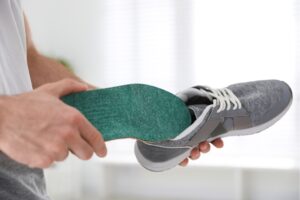Pes planus, commonly known as flat feet, refers to a structural deformity where the longitudinal arch of the foot collapses, causing the foot to have a flattened appearance. Normally, when you stand, walk, or run, the arches in your feet provide shock absorption, distribute your body weight evenly, and help you maintain balance and stability. Patients with flat feet have an impaired ability to absorb force, leading to pain and complications in the feet and joints above.

Classification
- Flexible flat feet: Medial Longitudinal arch of the foot collapses during weight bearing. When the foot is raised from the ground, the arch returns to normal.
- Rigid flat feet: have fixed arches that do not change shape with weight-bearing. Usually more severe and may require surgery.
- Congenital flat feet: Common in infants and typically flexible. Due to underdeveloped neuromuscular control and typically lasts until ages 5-6. In some cases, can lead into adulthood.
- Acquired flat feet: Typically due to dysfunctional posterior tibialis tendon, is associated with several co-morbidities. Can be flexible or rigid.
Causes and Risk Factors of Flat Feet
- Tightness in gastrocnemius and soleus muscles
- Dysfunctional posterior tibialis
- Excessive laxity in ligaments supporting the arch
- Excess weight gain
- Frequently waring shoes with poor support
Impact on the Knee: Genu Valgus
Genu valgus, otherwise knows as knocked knees, Is a condition commonly associated with flat feet where the tibia is angled toward the body’s midline.
With flat feet, the foot pronates (angled inward) at the ankle, changing the angle of the tibia. This causes the knee to bend inward. As the angle changes, more weight is applied to the medial side of the knee, putting excess strain on the MCL and medial meniscus. Over time, these changes to the knee biomechanics can result in knee pain and injury.
Impact on the Back: Lower Back Pain
Flat feet can have significant impacts on your posture increasing your risk of low back pain. One study found that 65.7% of 138 individuals suppering from low back pain had flat feet (Kosashvili etal., 2008). Another study, assessing spinal degenerative joint disease after a 14 year period found individuals with flat feet have are over 1.4 time more likely to develop a degenerative spine condition (Mei-Chou etal., 2021).
Examination & Orthotics
Here at Etobicoke High Performance Health Clinic we screen for conditions like flat feet using the Footmaxx gait analysis which assessed the distribution of weight across both your feet. Based on the results of the gait scan, our practitioners can determine if there is a need for orthotics. Our orthotics are custom made at Premier Orthotics Labs using 3D print technology, specifically designed to restore your arches and alleviate pain.
In managing flat feet, orthotics play a crucial role in providing support and stability. They help alleviate discomfort by correcting foot alignment and reducing the stress on the longitudinal arch and posterior tibial tendon. It is important to have the right orthotic based on your foot anatomy to prevent further misalignment and worsened foot pain.
While You’re Here…
Browse Services Available at EHP here: https://www.etobicokehealthclinic.com/services/
Check Out the Products we Carry In-Clinic and Online: https://www.etobicokehealthclinic.com/products/
Get To Know Our Staff: https://www.etobicokehealthclinic.com/practitioners/
Take a Look at Our Current Promotions: https://www.etobicokehealthclinic.com/promotions/
Read More Blogs From Us Here: https://www.etobicokehealthclinic.com/blog/
Book an Appointment Now: https://etobicokehighperformancehealth.janeapp.com/
Contact Us Here: https://www.etobicokehealthclinic.com/contact/ Follow Us on Instagram: https://www.instagram.com/ehpclinic/
References
- Raj MA, Tafti D, Kiel J. Pes Planus. [Updated 2023 May 23]. In: StatPearls [Internet]. Treasure Island (FL): StatPearls Publishing; 2024 Jan-. Available from: https://www.ncbi.nlm.nih.gov/books/NBK430802/
- Atik, A., & Ozyurek, S. (2014). Flexible flatfoot. Northern clinics of Istanbul, 1(1), 57–64. https://doi.org/10.14744/nci.2014.29292
- Michaudet, C., Edenfield, K. M., Nicolette, G. W., & Carek, P. J. (2018). Foot and Ankle Conditions: Pes Planus. FP essentials, 465, 18–23.
- Patel M, Nelson R. Genu Valgum. [Updated 2023 May 29]. In: StatPearls [Internet]. Treasure Island (FL): StatPearls Publishing; 2024 Jan-. Available from: https://www.ncbi.nlm.nih.gov/books/NBK559244/
- Kosashvili Y, Fridman T, Backstein D, Safir O, Bar Ziv Y. The correlation between pes planus and anterior knee or intermittent low back pain. Foot Ankle Int. 2008;29(9):910-913. doi:10.3113/FAI.2008.0910
- Mei-Chia Chou, Jing-Yang Huang, Yao-Min Hung, Wuu-Tsun Perng, Renin Chang, James Cheng-Chung Wei, Flat foot and spinal degeneration: Evidence from nationwide population-based cohort study, Journal of the Formosan Medical Association, Volume 120, Issue 10, 2021, Pages 1897-1906, ISSN 0929-6646, https://doi.org/10.1016/j.jfma.2020.12.019.


